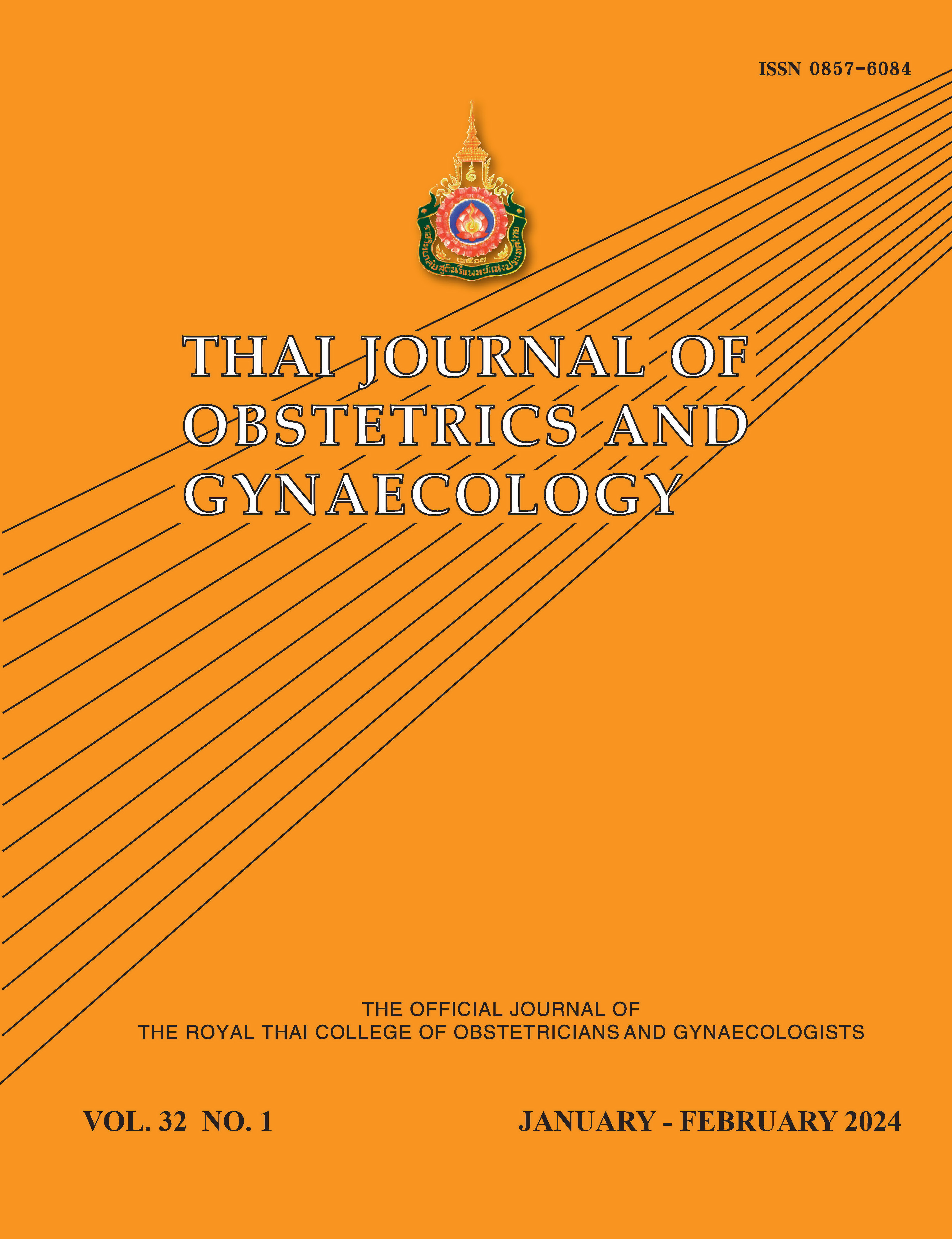mRNA Expression Profiling in Hydatidiform Mole: Comparison between Pre-Gestational Trophoblastic Neoplasia Moles and Remission Moles
Main Article Content
Abstract
Objectives: To explore potential mRNAs that can predict malignant transformation and identify mRNAs expression profile in complete hydatidiform mole.
Materials and Methods: A case-control study was conducted between complete hydatidiform moles that turned out to be postmolar gestational trophoblastic neoplasia (postmolar GTN) and complete hydatidiform moles that regressed spontaneously after evacuation (remission mole). We quantitatively assessed the expression of 770 human cancer genes from formalin-fixed paraffin embedded (FFPE) specimens or fresh frozen tissues using Nanostring nCounter. The differentially expressed genes between postmolar GTN group and remission mole group were analyzed.
Results: There were 12 cases recruited in this study: 6 remission moles and 6 postmolar GTN. Seven hundred and seventy genes were analyzed showing 29 genes that were significantly different in GTN moles compared to the remission moles. Nine of these genes (JUN, COL4A6, SOCS3, PLA2G10, NFKBIZ, FGFR3, CACNA1D, FGF7 and PLAU) were significantly different for more than 2 folds. The JUN had the highest different ratio and the lowest p value when compared between 2 groups (3.26 folds, p = 0.003). After reviewing their functions, JUN plays a role in several cancer initiations. These genes are promising biomarkers for prediction of postmolar GTN.
Conclusion: The analysis of mRNA profiles can distinguish between complete hydatidiform moles that will remission from those that will turn out to postmolar GTN. We identified 29 genes that were differentially expressed between the two groups. The results lead to further investigations on candidate genes and could probably explain the mechanism of malignant transformation to postmolar GTN.
Article Details

This work is licensed under a Creative Commons Attribution-NonCommercial-NoDerivatives 4.0 International License.
References
Froeling FE, Seckl MJ. Gestational trophoblastic tumours: an update for 2014. Curr Oncol Rep 2014;16:408.
Seckl MJ, Sebire NJ, Berkowitz RS. Gestational trophoblastic disease. Lancet 2010;376:717-29.
Wairachpanich V, Limpongsanurak S, Lertkhachonsuk R. Epidemiology of Hydatidiform moles in a tertiary hospital in Thailand over two decades: Impact of the national health policy. Asian Pac J Cancer Prev 2015;16:8321-5.
Zhao P, Wang S, Zhang X, Lu W. A Novel prediction model for postmolar gestational trophoblastic neoplasia and comparison with existing models. Int J Gynecol Cancer 2017;27:1028-34.
Wang Q, Fu J, Hu L, Fang F, Xie L, Chen H, et al. Prophylactic chemotherapy for hydatidiform mole to prevent gestational trophoblastic neoplasia. Cochrane Database Syst Rev 2017;9:CD007289.
Fulop V, Mok SC, Genest DR, Gati I, Doszpod J, Berkowitz RS. p53, p21, Rb and mdm2 oncoproteins expression in normal placenta, partial and complete mole, and choriocarcinoma. J Reprod Med 1998;43:119-27.
Kato HD, Terao Y, Ogawa M, Matsuda T, Arima T, Kato K, et al. Growth-associated gene expression profiles by microarray analysis of trophoblast of molar pregnancies and normal villi. Int J Gynecol Pathol 2002;21:255-60.
Niu YN, Wang K, Jin S, Fan DD, Wang MS, Xing NZ, et al. The intriguing role of fibroblasts and c-Jun in the chemopreventive and therapeutic effect of finasteride on xenograft models of prostate cancer. Asian J Androl 2016;18:913-9.
Thakur N, Gudey SK, Marcusson A, Fu JY, Bergh A, Heldin CH, et al. TGFbeta-induced invasion of prostate cancer cells is promoted by c-Jun-dependent transcriptional activation of Snail1. Cell Cycle 2014;13:2400-14.
Tanjore H, Kalluri R. The role of type IV collagen and basement membranes in cancer progression and metastasis. Am J Pathol 2006;168:715-7.
Nakano S, Iyama K, Ogawa M, Yoshioka H, Sado Y, Oohashi T, et al. Differential tissular expression and localization of type IV collagen alpha1(IV), alpha2(IV), alpha5(IV), and alpha6(IV) chains and their mRNA in normal breast and in benign and malignant breast tumors. Lab Invest 1999;79:281-92.
Ikeda K, Iyama K, Ishikawa N, Egami H, Nakao M, Sado Y, et al. Loss of expression of type IV collagen alpha5 and alpha6 chains in colorectal cancer associated with the hypermethylation of their promoter region. Am J Pathol 2006;168:856-65.
Dehan P, Waltregny D, Beschin A, Noel A, Castronovo V, Tryggvason K, et al. Loss of type IV collagen alpha 5 and alpha 6 chains in human invasive prostate carcinomas. Am J Pathol 1997;151:1097-104.
Shang AQ, Wu J, Bi F, Zhang YJ, Xu LR, Li LL, et al. Relationship between HER2 and JAK/STAT-SOCS3 signaling pathway and clinicopathological features and prognosis of ovarian cancer. Cancer Biol Ther 2017;18:314-22.
Chen X, Deane NG, Lewis KB, Li J, Zhu J, Washington MK, et al. Comparison of Nanostring nCounter(R) data on FFPE Colon cancer samples and affymetrix microarray data on matched frozen tissues. PLoS One 2016;11:e0153784.
Tam S, de Borja R, Tsao MS, McPherson JD. Robust global microRNA expression profiling using next-generation sequencing technologies. Lab Invest 2014;94:350-8.
Ragulan C, Eason K, Fontana E, Nyamundanda G, Tarazona N, Patil Y, et al. Analytical Validation of multiplex biomarker assay to stratify colorectal cancer into molecular subtypes. Sci Rep 2019;9:7665.


